#architect legacy
Text
Hogwarts Architect
I'm intrigued by the fact that he seems to have placed statues of himself all over Hogwarts.
He can be found in front of the entrance hall, in Hesperius hall and in front of the charms classroom.
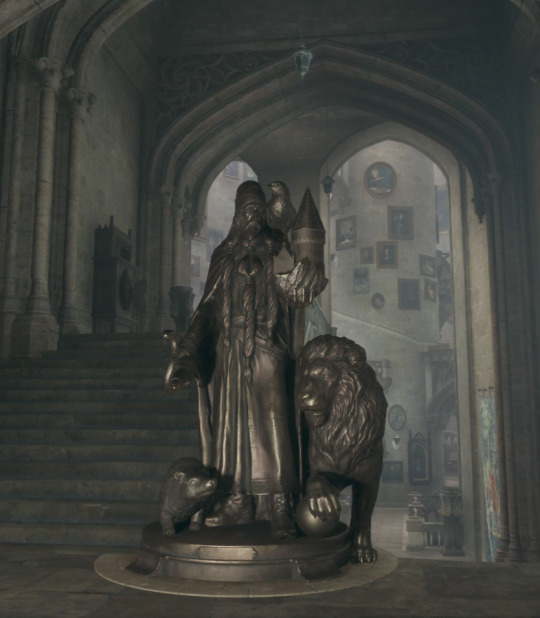
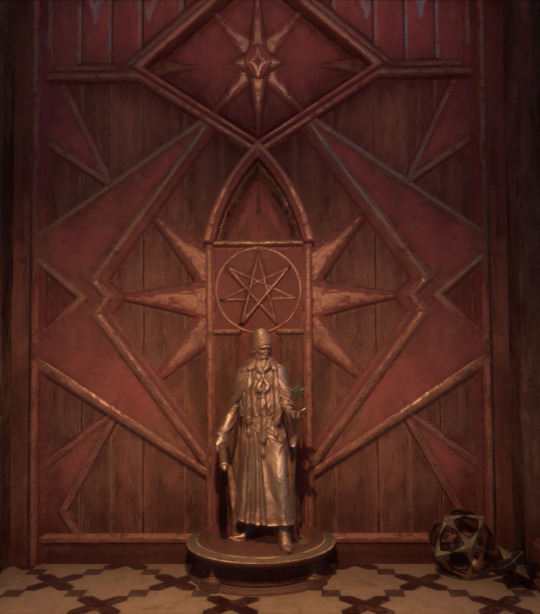

You can clearly see that all these statues are of the same man. He is very recognizable with his super snazzy, tripartite beard and the rolled up papers representing the plans to Hogwarts that he holds in one of his hands.
In the other hand, he always hold something different: a miniature version of Hogwarts in front of the entrance hall, a star in hesperius hall, which makes sense because Hesperius means evening star, and a globle in front of the charms classroom. Not sure why he is holding the globle there but it might be to represent a planet since the Astronomy tower is just behind where this statue is.
Anyway, all of this makes sense. Then there is this:
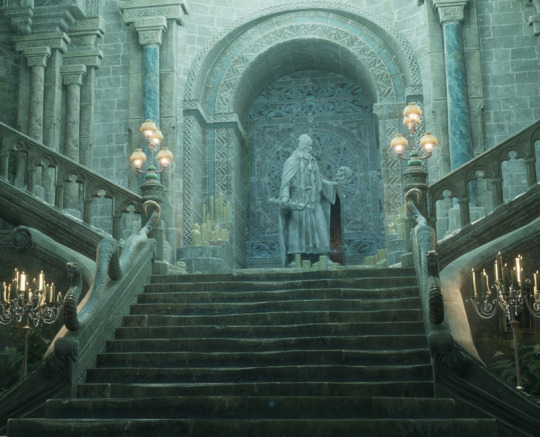
There is a huge statue of him in the Slytherin common room, in the place of honor in the middle of this huge staircase to the prefect's bedroom. Why?
I mean, there is no statue of him in any of the other common rooms. And it's not like he was a Slytherin himself. He build the castle, so he was already an accomplished wizard before Hogwarts was created. He couldn't have been sorted into Slytherin. So why place a statue of himself in this common room in particular and not the others?
Also, why is he holding a skull? He could have just been holding a snake to represent Slytherin, but no. Why hold a symbol representing death?
It's also the fact that this statue is huge and placed at this point of focus for the entire common room. You litterally can't miss it. I've seen many videos of people doing tours of the slytherin common room and they usually say this is a statue of Merlin or of Salazar Slytherin and that's what you would expect, right? They are both super famous Slytherins. But instead there is a statue of a man that wasn't even sorted into this house.
I'm just saying, it is intriguing...
56 notes
·
View notes
Text
I hate the end of Inquisition (the final battle, not the plot twist) for a lot of reasons, but what the Inquisitor does with Corypheus really takes the cake for me...
We spend the game learning about that fucker: We learn he walked physically in the fade once and wanna do it again, as some sort of final step in his little godhood trip. According the codex, in the alternative future where he already rules this world, he spends his time ragdolling Alexius to change what happened on the conclave so he can have the anchor back and go to the fade. In WHWE, Florianne also says that she will rule this world while that spoiled meatball rules the next. There are other ocasions where this is mentioned, but you got the idea.
We also learn that the bastard just refuses to die, because blight powers. Simple enough.
Now, Inquisitor, tell me how it was a GREAT idea to take the guy who was on his knees and USE YOUR MAGICAL FADE MARK THAT LETS PEOPLE WALK INTO THE FADE TO THROW THE FADE OBSESSED GUY INTO THE FADE.
I get it, rocks falling all around, not a lot of time, the archdemon is dead anyway, gotta deal with the bad guy before escaping. And yeah, I know he kinda gets pulled apart/disintegrate when Inky does their thing. I just think that when the last person who killed the guy says he was "dead on the ground", had "no breath, no heartbeat" and you know the guy got better and almost destroyed the world, you might want to... I don't know, make sure?
Plus, this is the "let nothing die and bonus points if Hawke was around at some point" franchise. I mean:
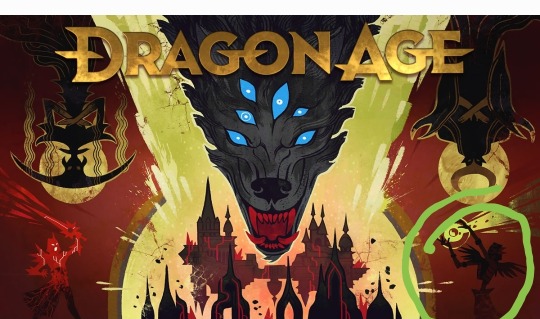
(btw: Hey Mery, welcome back)
So yeah, the end of Inquisition makes me mildly annoyed
#Corypheus is my responsability#i hoped that would be the architect#but the architect doesn't have a green orb unfortunately#technically neither does Corypheus#so i'm hoping this is just a nod to Cory not a real plot point#can you just imagine Hawke strolling around the fade and Corypheus crazy ass falls through the sky tho#the screams#the horror#sure is buddy#might as well add him as a romance option/s#seriously give me the Architect#my boy has a good reasons to still be alive#dragon age#dragon age inquisition#dragon age dreadwolf#da4#hawke#the inquisitor#inquisitor#dragon age 2 legacy#corypheus#the fade#also we potentially let a warden in the fade#just possess the warden already#half of us didn't even get xp for the bastard#i got bugged in the first phase and he still had 1hp no matter what i did
19 notes
·
View notes
Photo

https://robbrechtendaem.com/
#Robbrecht en Daem architecten#architects#architecture#design#studio#portfolio#Ghent Belgium#white#typography#type#typeface#font#Antique Legacy#2022#Week 26#website#web design#inspire#inspiration#happywebdesign
8 notes
·
View notes
Text
What we were born for
I've been left asking that question with each start
To be in the spotlight, to fight for internal light, to see the sun
To be seen by big white eyes, and to be managed by hands who have no direction nor order
Birth, life. Fall, thread-spin. Rinse repeat
Not like I had any choice in the matter, not like any of us did. And yet...
Ah, I can't help it, to let go of the past...I suppose that will never be my style.
#perceptive little crow#ok hi actual interpretations and serious discussion#like first and foremost - WOW. it caught me so off guard the very first few notes. i was not expecting this at all. AND FOR THE BEST#holy shit. like outside the legacy instruments. the stuff used for this specific version is *chef's kiss*#classy and mysterious. casual but y'know something's going on beneath#and don't get me started on the fucking architect motif. oh my god#like outside it being used MASTERFULLY across the entire song (not too much nor too direct but still keeping it alive by spirit)#it just. hurts so much#so much#it's a past desperately asking to not be left out. to be allowed to be given the light it was never able to#the way it was used specifically sounds like a funeral. mournful of itself. afraid of the brighter future#yet...there's glimpses of hope in its cry. clinging to net 0 hope#yet being listened to#listened on and on. it does not know. probably never will. but its voice and sorrow will be what brings it to life#and for its hope to bloom into the brightest‚ most beautiful flower beneath the warming sun#(probably doesn't convey my feelings about this well + first impressions. will 100% change over time. but fucking christ oh my god)
0 notes
Text
"Pv Narasimha Rao: Honoring the Architect of India's Economic Transformation"
“Pv Narasimha Rao: Honoring the Architect of India’s Economic Transformation” pv Narasimha Rao, architect of India’s economic transformation, honoring, PV Narasimha Rao’s legacy, economic reforms in India
the Architect of India’s Economic Transformation
A Bharat Ratna, India’s highest civilian award, to be bestowed upon Former prime minister Pv Narasimha Rao and agricultural scientist Dr. Ms…

View On WordPress
#pv Narasimha Rao#architect of India&039;s economic transformation#economic reforms in India#honoring#PV Narasimha Rao&039;s legacy
0 notes
Text
Obsession is the Engine
I am Obsessed with Success Quotes
1. “Obsession is the engine that fuels the pursuit of growth and change.”
2. “Hard work is the cornerstone of success; obsession is the architect of transformation.”
3. “In the realm of progress, obsession is the compass pointing towards excellence.”
4. “Dedication is the ignition, but obsession is the relentless drive for continuous improvement.”
5. “To…

View On WordPress
#Achieving greatness.#Architect of a Successful Life#Building a Celebrated Life#Canvas of Excellence#Continuous Growth Journey#Crafting a Legacy#Dance of Accomplishment#Fuel for Challenges#Fulfilling Adventure#Gravitational Force of Dreams#Guiding Principle of Fulfillment#Guiding Star of Success#Illuminating the Path to Success#Living a Life of Significance#Magic Wand of Obsession#Marked by Success#Masterpiece in the Making#Obsession for Success#Pinnacle of Success#Positive Impact Obsession#Purposeful Life#Pursuit of Dreams#Recognizing Success#Reflection of Unwavering Obsession#Relentless Pursuit#Relentless Self-Discovery#Symphony of Dedication#Symphony of Success#Triumph Tapestry#Unwavering Dedication
0 notes
Photo
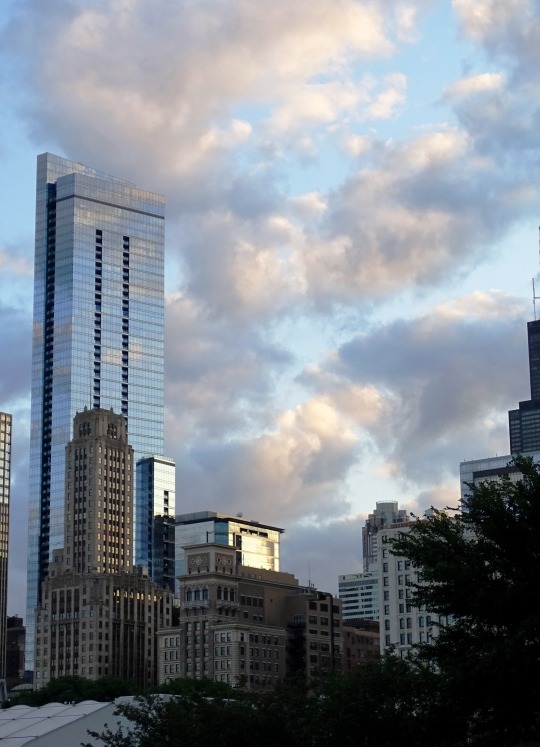









Clouds (No. 859)
Chicago, IL
#Legacy at Millennium Park#Lakeshore East Park#Lake Michigan#Chicago#evening light#blue sky#clouds#architect#skyline#skyscraper#reflection#summer 2019#original photography#tourist attraction#landmark#architecture#cityscape#Illinois#Midwestern USA#Great Lakes Region#Chicago Lakefront Trail#daylight#vacation#travel
1 note
·
View note
Text
Consider this my attempt to say to the field of architecture in a way that matters: Do not participate in this. Do not build shiny skyscrapers on the graves of entire lineages wiped out in a single blast, or luxury condos on the barren land where, before the bombs fell, Palestinian families were forcibly removed from their homes. Do not wag your finger and say “It’s complicated” when the world has seen the footage of people searching for their loved ones among a sea of white body bags, and of journalists weeping on television after hearing of the killing of their wives and children. Do not contribute to this violence, and do not give it an architectural form. Do not contribute to the legacy of architects who profited from the devastation of thousands of innocent human lives. Do not do it. It is my hope that many architects and firms will refuse work in an ethnically cleansed Palestine, just as they had the moral clarity to suspend their projects in Russia after Putin’s invasion of Ukraine. But to those who will answer disaster capitalism’s call: When the buildings are completed and the world looks back on this moment with great shame, you will be implicated, and those who chose not to be complicit will not forgive you.
880 notes
·
View notes
Text
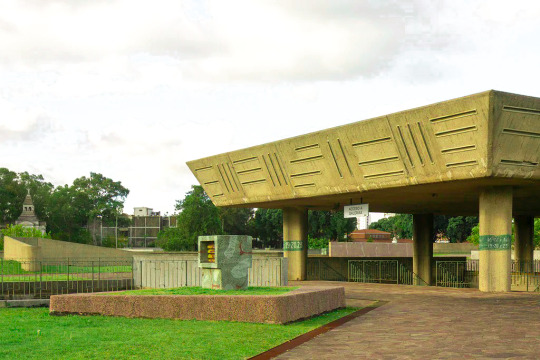
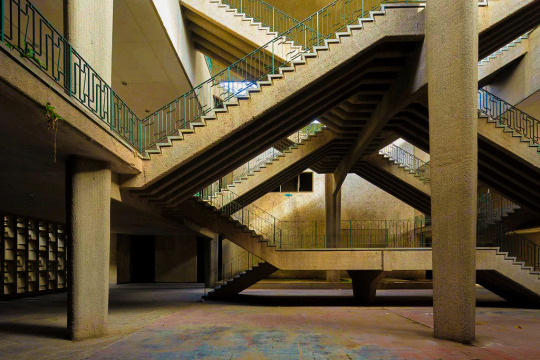
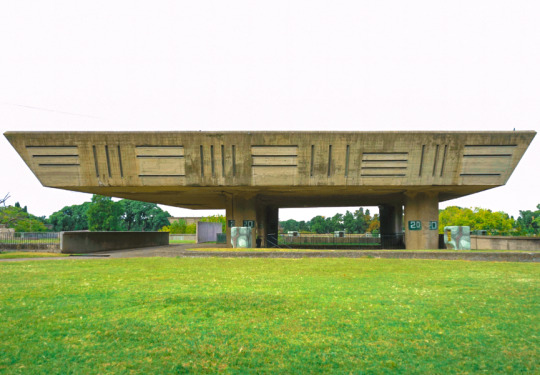
The Sixth Pantheon of the Chacarita Cemetery, located in west Buenos Aires, was built during 1950-1958 and designed by one of the first female Argentine architects, Itala Fulvia Villa, a key figure in Argentina’s modernist architectural legacy and a member of the Grupo Austral.
For years the work was solely credited to Clorindo Testa, despite his more minor collaborative role in the project designing the concrete temple and the Torii-gate-style monuments scattered above ground.
The Pantheon is the first modernist work of its kind applied to the design of a cemetery on this scale, created to house 40,000 niches. A labyrinthine network of subterranean galleries and vaults is interconnected by a series of walkways, punctuated by open courtyards and patios characterised by hanging wall planters and vegetation. The result is an oasis of calm split over two levels below ground accessible by generous stairwells, all hidden from view from the landscaped garden above.
330 notes
·
View notes
Text
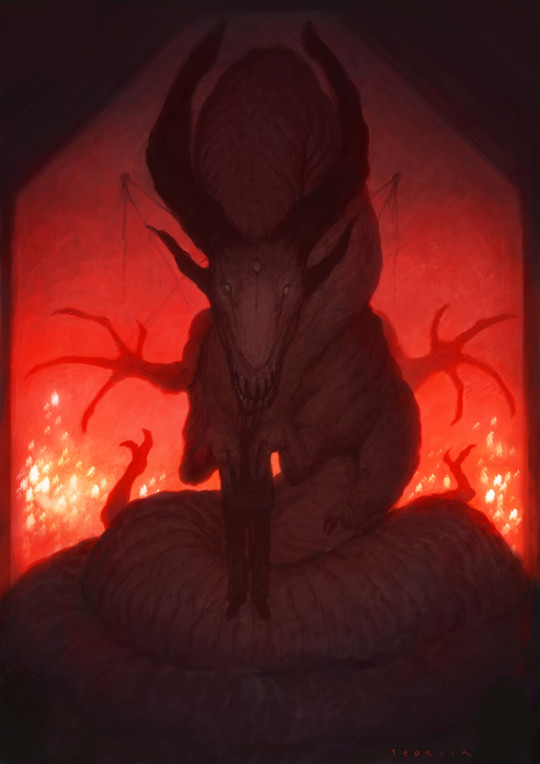
Villain: The Lauding Worm
Born of hubris and old glories gone rotten, this pallid demon of pride exists to parasite those that consider themselves great; Lurking in the walls of their ancestral estates, whispering in their ear, bloating along with their egos, inevitably driving them to cruelty and ruin as it's appetite and expectations grow ever larger.
Adventure Hooks:
The party are travelling through the wilderness when they encounter a richly attired knight exhausted and on the edge of collapse. After helping her recover, she shares that she is part of a noble family renowned for their legacy of dragonhunting, a life threatening challenge she must exceed if she is to honour her family and claim her inheritance. The expectation of this great and dangerous deed has worn heavy on her shoulders all her life, and has become all too literal now that the demon has invisibly coiled about her neck. Fresh off it's latest incarnation, the Lauding worm is small for the moment, feeding off the knight as she destroys herself for the sake of legacy and will not allow her to be dissuaded from her doomed quest. It may infulence the party to join her however, seeing the potential for gorging on greater glory should the dragon slaying succeed. It the aftermath of the battle, or perhaps some weeks later, the Lauding worm will convince the dragonslaying knight that the great do not share their glory, and that she must eliminate the party so they do not tell of her weakness in needing aid, or her shame in not striking the final blow.
Something is wrong with the king, and the whole realm suffers for it. Obsessed with building expansions to his palace he neglects the welfare of his realm and the stability of his court to empty the treasury into ever more elaborate construction. Brigands run wild, his underlings scheme and attempt to seize each other's territory, and all the while the king pours over the plans of his architects and demands they build more. The Lauding worm has gotten to him, it lives and grows in the castle walls, and the more the king builds the bigger it gets. The servants whisper of rumbling behind the walls, and though it is excused as the byproduct of the constant renovations, it's only a matter of time before the demon's growth exceeds what can be constructed and it breaks free to rampage across the land.
The Lauding Worm has a special reward for those who feed it best, realized only in the rare times it grows bored of gorging itself on the pride of others and seeks to enact its own ambitions. Taking the guise of a mortal necromancer it raises it's favoured hosts from their graves and turns their talents towards Conquest.
Artsource
#fiend#mid level#villain#villain demon#villain noble#random encounter#wilderness encounter#dragon#monster hunt
261 notes
·
View notes
Text
LEVEL 1: STARTER
Build #1, Build #2, Build #3, Build #4, Build #5
To start this challenge, begin with House #1: Barely a Garden Shed and move your Architect into the lot. Set your money to 0.
Because this is the first house and your Architect has nothing, you may purchase items & build your house as you are able to afford it. However, for all remaining houses in this legacy challenge, you must save your money first, then build. If at the end of the build you still have money leftover (though you should really aim to max the allotted budget), you may carry that money forward to your next build.
Level 1 Rules:
You may use Debug items
You may make any of these houses a Tiny Home (Tiny Living)
No Custom Content
Each house must include the requirements from the previous houses.
#ArchitectLegacy#architect legacy#ncstone#the sims#the sims 4#legacy challenge#rags to riches#build challenge#building#sims build#architecture#design#interior design
0 notes
Text

Chrysler Building: A Shimmering Icon of Art Deco Elegance
In the heart of Manhattan's bustling skyline, one architectural masterpiece stands tall, capturing the imagination of all who gaze upon it. The Chrysler Building, a shimmering beacon of Art Deco elegance, is not just a skyscraper but a symbol of New York City's enduring spirit and architectural innovation. With its captivating history, exquisite design, and a touch of old-world glamour, the Chrysler Building continues to enchant and captivate, leaving an indelible mark on the Big Apple's iconic skyline.
The Chrysler Building, completed in 1930, was the brainchild of architect William Van Alen. Its distinctive design is a symphony of style, blending Art Deco with influences from the Machine Age. The tower rises to a staggering 1,046 feet, making it one of the tallest buildings in the world at the time of its completion. Its crowning glory, the iconic stainless steel spire, reaches even higher, ultimately soaring to 1,476 feet. This bold architectural choice, combined with the building's tiered setbacks and intricate ornamentation, immediately sets it apart from its contemporaries.
The Chrysler Building's spire is nothing short of a masterpiece. Composed of seven concentric stainless steel arches, it seems to ascend endlessly into the sky, a testament to human ambition and ingenuity. The polished metal glimmers and reflects the ever-changing hues of the New York City skyline, giving the building a dynamic and ethereal quality. The spire's tip is adorned with a spectacular sunburst design, a symbol of hope and optimism that encapsulated the spirit of the Roaring Twenties.
Beneath the shimmering façade, the Chrysler Building holds a treasure trove of architectural marvels. The lobby, in particular, is a breathtaking work of art. A soaring, marble-clad space is adorned with ornate, artful details, including intricate friezes, Egyptian-inspired motifs, and a magnificent ceiling mural by artist Edward Trumbull. The lobby's elegance and opulence transport visitors to a bygone era of sophistication and glamour.
The Chrysler Building's enduring legacy goes beyond its architectural significance. It has played a prominent role in popular culture, making appearances in numerous films, television shows, and works of literature. Its silhouette, unmistakable and timeless, is a symbol of New York City itself, representing both the city's storied past and its ever-evolving future.
Yet, beneath its polished surface and captivating design, the Chrysler Building harbors an air of myth and mystery that adds to its allure. One enduring legend is the tale of a secret spire race between the Chrysler Building and the Bank of Manhattan Trust Building (now known as 40 Wall Street), a nearby skyscraper under construction at the same time. This tale, though perhaps more myth than fact, only deepens the intrigue surrounding this architectural wonder.
The construction of the Chrysler Building was not without its challenges. The architects and builders had to contend with the limitations of 1920s technology, including the absence of modern safety measures and equipment. Nevertheless, the determination and expertise of the builders triumphed over adversity, resulting in an enduring symbol of human achievement.
As we look ahead to the future, the Chrysler Building continues to stand as a symbol of resilience and creativity. While no longer the tallest building in New York City, its timeless elegance and iconic spire remain a source of inspiration for architects, artists, and dreamers alike. Recent renovations and preservation efforts ensure that this shimmering gem will continue to grace the Manhattan skyline for generations to come.
For those who wish to experience the magic of the Chrysler Building firsthand, tours are available to explore its exquisite lobby and learn more about its history and architectural significance. Standing in the shadow of its gleaming spire, visitors can connect with the past, marvel at its beauty, and imagine the countless stories that have unfolded within its walls.
In a city that is constantly changing and reinventing itself, the Chrysler Building remains a steadfast symbol of New York City's enduring spirit, artistic excellence, and architectural innovation. Its shimmering spire reaches for the heavens, while its hidden treasures and legendary history capture the hearts and minds of all who encounter it. As an icon of Art Deco elegance, the Chrysler Building is not just a skyscraper; it's a living testament to the dreams and aspirations of a city that continues to inspire the world. It's a reminder that in the ever-evolving urban jungle of Manhattan, the Chrysler Building's brilliance still shines as brightly as ever, inviting all to partake in its timeless allure.
Chrysler Building - Next page>
#Chrysler Building#new york city#new york#new-york#newyork#urban#nyc#ny#manhattan#city#usa#United States#buildings#travel#journey#outdoors#street#architecture#visit-new-york.tumblr.com
469 notes
·
View notes
Text
Hogwarts Legacy Character Sheet - Gwendolen Hedera
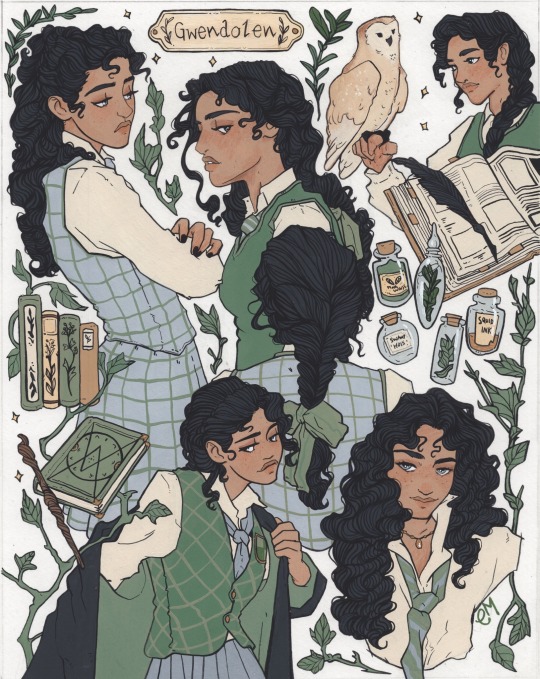
General Information
Full Name: Gwendolen Hedera
Nicknames: Gwen, Wendy, The Hero of Hogwarts, The New Fifth Year
Gender: Female
Date of Birth: April 26th, 1875
Zodiac Sign: Taurus
Personality Type (MBTI): INTJ - The Architect
Species: Human
Blood Status: Unregistered
Alignment: Chaotic Good
Nationality: British
House: Slytherin
Wand: Fir wood with a phoenix feather core, 11 3/4”, rigid flexibility
Patronus: Stoat
Boggart: The mutilated corpse of Professor Fig
Amortentia: Bread pudding, wax candles, old books, fresh linen
Physical Appearance
Hair Colour & Style: Black; occasionally wears down but is most often seen sporting it braided or in a ponytail.
Eye Colour: Grey
Skin Tone: Olive with neutral undertones
Height: 167cm (5’6”)
Weight: 55kg (121 lbs)
Clothing Style: Neat and presentable; favors skirts, ruffled blouses, vests, and heeled boots. Almost never wears her robes.
Accessories: Black painted finger nails. A necklace gifted to her from Natty.
Personality
Positive Traits: Adaptable, determined, loyal, resilient, compassionate, curious, diligent
Neutral Traits: Independent, reserved, ambitious, rational, observant, competitive
Negative Traits: Arrogant, cunning, stubborn, sarcastic, defiant
Strengths: Capable of thinking outside the box and extremely quick-witted
Weaknesses: Thinks she knows what’s best and struggles to let people in
Likes: Cats, Summoner’s Court, Quidditch, organization, leadership, exploring the highlands, reading
Dislikes: Spiders, Gobstone’s, dugbogs, failure, meat, laziness, clutter
Background and Family
Gwendolen Hedera was born on April 26th, 1875, in East London to parents of unknown wizarding heritage. At the age of five, Gwendolen was in a carriage incident which tragically took her parents lives and left her with amnesia. She was ultimately raised at Mission of Love, a Muggle orphanage where she was subjected to mental, verbal, and occasionally physical abuse. Once she grew older, she was shuffled from household to household and learned that in order to get what she wanted she had to manipulate the people around her. She earned a fair education living amongst some of the wealthier families in London but never had the one thing she truly wanted - familial love. When she was fifteen, Gwendolen found herself whisked away from the orphanage by Professor Eleazar Fig, never to be seen again.
After Professor Fig’s death, she found herself under the guardianship of Matilda Weasley, Deputy Headmistress and Transfiguration professor. It took some convincing from Ominis for her to accept the offer, and she kept herself at arms length around Professor Weasley, secretly fearing that she would abandon her when things became too difficult. During the summer between her fifth and sixth year, she met the rest of the Weasley clan and grew closer to Garreth Weasley, who she begrudgingly helped with his experiments. With time, she came to view Professor Weasley in a maternal light (the feeling was mutual on Matilda’s part).
Biological Father: Unknown (Deceased)
Biological Mother: Unknown (Deceased)
Guardian/Adoptive Parent: Matilda Weasley
Adoptive Uncles: Graham Weasley, Phillip Weasley
Adoptive Aunts: Dorothy Weasley (née Button), Lydia Weasley (née Hawthorne)
Adoptive Cousins: Theodore Weasley, Oscar Weasley, Garreth Weasley, Florence Weasley, Millicent Weasley, Francis Weasley, Edmund Weasley
Relationships
Love Interest: Ominis Gaunt/Sebastian Sallow…ehhh it’s complicated…
Best Friends: Natsai Onai, Poppy Sweeting, Garreth Weasley, Imelda Reyes, Amit Thakkar
Acquaintances: Nerida Roberts, Grace Pinch-Smedley, Lucan Brattleby, Isaac Cooper, Adelaide Oakes
Rivals: Leander Prewett, Charlotte Morrison, Samantha Dale
Enemies: Ranrok, Victor Rookwood, Theophilus Harlow, Ashwinders, Cassius Caine (OC), Elspeth Iris (OC)
Pets: Vivarium beasts, eleven cats, a barn owl named Minerva
• Artwork done by the incredible @millyillus •
#gwendolen hedera#ominis gaunt#sebastian sallow#natsai onai#poppy sweeting#garreth weasley#amit thakkar#imelda reyes#matilda weasley#hogwarts legacy mc#slytherin#slytherin mc#hphl mc#hogwarts legacy oc#the girl with the resting bitch face#character sheet
162 notes
·
View notes
Photo

https://www.morkulnes.com/
#Mork-Ulnes#architecture#studio#architects#San Francisco#Oslo#wood#Scandinavian practicality#Californian can-do spirit of innovation#portfolio#typography#type#typeface#font#Antique Legacy#2022#Week 18#website#web design#inspire#inspiration#happywebdesign
3 notes
·
View notes
Text
Monstrous Wardens Masterpost
A great big collection of text from the Dragon Age games and novels about darkspawn, Grey Wardens, and the Calling, to fuel everyone's monstrous wardens headcanons.
This has actually been sitting in my drafts for like half a year now bc I thought I really should scrounge around for more quotes from Last Flight, Awakening, and Legacy. That... didn't happen, and there's really no sense in holding off longer. If I ever do get around to it, I'll pull more quotes to add. But I consider this complete as is. enjoy~
—
The Song
The Old Gods will call to you,
From their ancient prisons they will sing.
Dragons with wicked eyes and wicked hearts,
On blacken'd wings does deceit take flight,
The First of My children, lost to night.
—Canticle of Silence 3:6, Dissonant Verse
“The Old Gods beckon, as they always have.” The Architect turned and paced to the other side of the cell. The shadows cast on the walls by the glowstone danced ominously. “That is what you hear. To my people, it is a call that we cannot ignore. It whispers to our blood and compels us to seek the Old Gods out. We search and search for their prisons, and when we find one, we touch the face of perfection and thus desecrate it forever.”
—Dragon Age: The Calling, chapter 6
So close. We nearly reached him. Made it down to what looked like a dwarven thaig where the song was actually audible, real and thrumming through the air, not just in our heads. It rattled through the lyrium pillars and shook the earth beneath our feet to its dreadful tempo.
—[DAI] Note: Ancient Warden Logbook
There were creatures in that land. Dark things that lurked in the corners. Cole couldn’t see them, and didn’t want to. He worried that they could see him, however. […]
And worse, there was the music. He didn’t know what it was, but it seemed to come from far, far off. It called to him, but not in a pleasant way— it had an urgency that sped his heart and made his blood burn. The dark creatures, the lurkers, they listened to it. He didn’t know how he knew that, but he could feel them out there, craning their necks, raising taloned hands toward that call.
—Dragon Age: Asunder, chapter 9
As the griffon began to climb through the clouds that followed the Blight, Isseya heard a faint, strange melody seep into her mind. She had no sense of it as actual sound; rather, it seemed to come from within, almost as if she were humming the tune to herself.
She could never have imagined such a song, though. It was the most beautiful thing she’d ever heard. Aching and ethereal, it seemed to pull her toward a memory of nostalgic bliss that she had somehow lost—but that she would do anything to recover. Anything at all. […]
“What was it?” the elf asked, shaken. […]
“The Archdemon.” […]
For the rest of their ride back to Antiva City, Isseya sat small and quiet on Blacktalon’s back, unable to reconcile the horrors of the darkspawn with the sweetness of their song.
—Dragon Age: Last Flight, chapter 3
The Chorus
The faint sounds of movement ahead got more frequent, and along with them, they began to hear a strange humming. It was deep and alien, a reverberating sound that they felt in their chests and that made their skin crawl. […]
The deep humming was coming from [the creature. It] was moaning softly, almost chanting, and this moan built upon the sounds of many others behind it in the shadows. They hummed in unison, a hushed and deadly whisper the creatures spoke as one. […]
All of them walked as calmly as the first, shambling toward them while moaning and hissing softly. The sound was loud now, reverberating around them like a physical force. […]
They watched the darkspawn advance, their weapons held at the ready. Even with their prey cornered, the creatures did not accelerate. Their hum became louder, reached a hungry, fever pitch.
—Dragon Age: The Stolen Throne, chapter 14
Were they digging? He had the impression that the masses of them were all engaged in some sort of industry, all united in moving great portions of the rock out of the cavern and expanding it even further. Yet there were no sounds of tools crashing against stone, no hammering sounds or grunts of exertion. All he could hear was a rhythmic groan, a keening pitch that it seemed each of the darkspawn contributed to. The sound of it made his skin crawl, and he realized that the chorus in the distance responded to it. Like a cat that arched its back to meet a brushing hand it became ecstatic; it surged and almost overwhelmed his senses.
—Dragon Age: The Calling, chapter 6
The Senses
They were more than simply skilled at fighting darkspawn; they knew them intimately. They sensed their presence, sometimes even gleaned their intent.
—Dragon Age: The Calling, chapter 4
He could feel the darkspawn out there now. Genevieve was right. It just took some time to become acclimated. They were at the edge of his consciousness, lurking in the shadows far out of sight. It was that same feeling when someone was standing behind you, and you didn’t hear them or sense them in any way; you just knew.
—Dragon Age: The Calling, chapter 5
Bregan closed his eyes and carefully reached out with his senses. There were darkspawn all around him. Not in the same room, perhaps, but nearby. He could feel them tickling at the edge of his mind. As always, the sensation came with a feeling of foulness, as if a poison had seeped under his skin.
—Dragon Age: The Calling, chapter 2
“There is a taint that is within the darkspawn […] A darkness that pervades us, compels us, drives us to rail against the light. It is in our blood and corrupts the very world around us.” The creature gestured toward Bregan with a withered, taloned hand. “It is also within your blood. It is what makes you what you are, what you sense in us and we in you.”
—Dragon Age: The Calling, chapter 2
Anders: Hmm.
Hawke: What's wrong?
Anders: I think [the Grey Wardens are] nearby.
Anders: Or it could be darkspawn.
—Dragon Age II
The hunter had a sensitivity to the taint that went far beyond any tracking ability he might have learned during his time with the Ash Warriors. He was always the first to sense the approach of darkspawn, and he could discern between the various breeds by their scent alone. Some of the Grey Wardens even used to claim that Kell could do the same with them, sense who was who from afar just as if they were darkspawn. If so, the hunter never commented on it.
—Dragon Age: The Calling, chapter 11
She felt Bregan out there, felt him just the same as she felt the darkspawn. Every now and again she would turn a corner in the tunnels and would feel her brother’s presence on the edge of her senses, almost as if his scent had been carried to her somehow on an invisible wind.
—Dragon Age: The Calling, chapter 15
The Dreams
Alistair: Oh… and then there were the nightmares. Duncan said it was part of how we sense the darkspawn. We tap into their… well, I don't know what you'd call it. Their “group mind.”
Alistair: And when we sleep, it's even worse. You learn to block it out after a while, but at first it's hard. It's supposed to be worse for those who Join during a Blight. How is it for you?
Warden: Nightmares… yes, I know what you mean.
Alistair: Some people never have much trouble, but that's rare. Others have trouble sleeping their entire life. They're just more sensitive, I suppose.
Alistair: Everyone ends up the same, though. Once you reach a certain age, the real nightmares come. That's how a Grey Warden knows his time has come.
—Dragon Age: Origins
The dream, when it came, was similar to the hundreds of dreams Fiona had suffered since she’d become a Grey Warden. Before, however, it had always felt as if she was looking on the dream from afar, hazy and easy to forget. Now it was crystal clear.
Fiona stood on a battlefield littered with dead men. All of them were soldiers in heavy armor, knights wearing the griffon standard of the order. Each had been brutally slaughtered. The smell of blood and decay hung thick and cloying in the air, the buzzing sound of flies nipping at her senses.
Overhead, the sky filled with an endless, roiling black cloud. It looked like ink spreading slowly in water, a great stain that blotted out the horizon. She had been told about this. The first sign of the Blight, said the Grey Wardens, is found in the clouds. When the mighty dragon rises, its corruption touches the world and spreads.
She was alone on that field of corpses. All alone. The wind picked up, a sickly breeze that carried with it the stench of carrion. A gloom fell upon her, and she stumbled as she watched something rise from out of the field of bodies nearby. It was enormous. A great, black thing that was as cold and terrible as anything she could have imagined.
Fear pulsed through her. Her heart raced, and she looked away. She didn’t want to see it. She threw her hands up in front of her eyes not to see it. Yet still she felt it coming. Her foot caught between two corpses and made her fall back on top of them. Dead flesh pressed against her and still she covered her eyes. Still she felt the darkness surging ever closer to her.
It was coming. And it was coming for her.
—Dragon Age: The Calling, chapter 14
The Calling
Hawke: You don't look well, Bethany. Are you injured?
Bethany: Injured? I have the darkspawn taint forever in my veins, barely held in check by the Wardens' rituals.
Bethany: I will never be well again.
—Dragon Age II
At first, it was just a whisper. A creak in the door hinge I could put off oiling. But soon, all I could hear was the music. It was there when I swung my staff and wiped the sweat from my brow. It lingered in Lyam's laughter and stalked my dreams. I can't explain the sound—the song—but I knew. It's a poison that grows in the mind, then consumes the body.
—[DAI: The Descent] Codex Entry: Warden Ailsa's Diary
It scratches at my thoughts, the music almost a voice, at once unearthly and beautiful. I found myself humming it aloud a few days past. Where once it intruded, it now feels a natural part of my mind's course. It coils around memories I hold dear—training with Ser Keller, riding in the moonlight, my mother's face the last time I saw her—and inserts itself into them, so that I could almost swear that music, that sense of a presence watching and calling, had always been a part of what I remember.
—[DAI] Codex Entry: Regarding the Calling
She had seen enough of the corruption to last a lifetime, and somewhere off in the far distance was that strange sound, the beautiful whispering.
She didn’t want to listen to it, but couldn’t help herself. She closed her eyes and tried to pick out what the whisper was saying. Was it a song? Was it a name? It almost seemed that it was calling out to her, stroking her soul ever so softly. . . .
—Dragon Age: The Calling, chapter 14
The humming sound, however, was stronger even than before. It was no longer something muted and distant; it was everywhere. It was behind the walls and under the floor; it filled the shadows and caressed his skin. There was a terrible beauty to it now, an awful yearning that pulsated within the sound, a tugging that pulled at the edge of his consciousness and yet frightened and nauseated him at the same time.
The humming had eclipsed any sense he had of the darkspawn. Any attempt he made to reach out with his mind to sense where the creatures were found only a wall of beautiful sound instead. Like a weed, it had insinuated itself into his consciousness, blocking out anything useful.
—Dragon Age: The Calling, chapter 6
The far-off chorus had become a powerful symphony, a great swell of beautiful music that no longer pounded to get inside his head but instead tickled at the edges of his thoughts. It was far easier to ignore, but now he found it distracting. He found himself losing his train of thought whenever he listened.
—Dragon Age: The Calling, chapter 10
The taint fogged her thoughts a little more with each passing morning. Her diary, once a detailed chronicle of every day’s thoughts, went neglected for weeks, sometimes months. She was losing her mind.
She wasn’t the only one, of course. It had gotten harder to tell the reality of the Blight from the horrors of her dreams. Sometimes she wasn’t sure which one she walked through, or which one she fought in. The elf had learned to recognize the confusion that sometimes passed over other senior Wardens’ faces. They, too, heard the Archdemon’s song echoing through their heads, a trifle louder every night. They, too, fought to block it out and to hide the signs from their comrades…
—Dragon Age: Last Flight, chapter 21
My body is breaking down. The fingernails were the first to go. I started to itch all over, and when I scratched, they peeled back. Clumps of hair fell away. Then clumps of flesh.
I hear a song in my head. It's deafening. The most beautiful thing I've ever heard. But I don't hear it with my ears. It's in my brain. A blissful sound. This must be the call for which the darkspawn yearn, what causes them to dig so feverishly.
I'd still rather die. Suppose that's something.
—[DAI] Codex Entry: To Be Corrupted
His skin itched terribly underneath those bandages, but he resisted the urge to peel them off. The pain throughout his body was dull but insistent, as if his body protested against this unfamiliar movement. The sluggishness made him wary. There was a thickness to his blood, a deliberateness to his heartbeat that made him feel like something alien was crawling inside of him and sapping his strength.
[…His arms] were half covered in dark blotches. At first, he wondered if that was some kind of injury, or perhaps a bloodstain. But then he noticed the texture of the skin within those discolored areas: rough and withered, just as darkspawn flesh was. […]
Every part of his skin that wasn’t covered by the greyed cloth bandages was corrupted. It was like a network of black mold working its way across his entire body, and everywhere it touched he could feel a hot buzzing underneath the flesh. It was difficult to look at.
—Dragon Age: The Calling, chapter 6
The Architect stared into Utha’s eyes and nothing happened at first. Then black veins began to appear along her hand where the darkspawn touched her. They became darker and darker, the veins branching until her entire hand was criss-crossed with them. […]
Her flesh withered and curled, the air filling with the foul stench of decay. […]
The stain on her skin spread, crawling up her neck and covering her face. Her coppery hair began to grey, and then it became white. Her long braid twisted and curled behind her, like a match that was burning itself into a cinder. Her eyes shot open, blood red, and she opened her mouth in a soundless scream... and what wisps remained of her hair simply fell out.
And then it was done.
—Dragon Age: The Calling, chapter 16
Bonus entry that made me go "hey what the fuck"
What I remember most is its tongue flapping against a row of spiky teeth. I'd heard emissaries possessed the ability to speak, but the words were unnatural. They twisted and lurched as they left the creature's mouth, accompanied with a spray of saliva.
"Have you ever experienced living flesh ground between your teeth?" it asked Mila before biting through her throat.
—[DAI: The Descent] Codex Entry: Darkspawn Emissary
399 notes
·
View notes
Text
[...] [A]side from strengthening ties with the Zionist settler-colony of Israel, which became a major US ally during the Nixon and Ford years, Kissinger armed Israel to the teeth during the 1973 war in order “to prevent an Arab victory”. His emergency military help to Israel during the war reversed the early victories of the Egyptian and Syrian armies and ensured that Israel won the war. He also ensured that no US relations could be established with the Palestine Liberation Organisation.
In September 1975, Kissinger signed a “memorandum of understanding” with the Israelis committing the US not to recognise or negotiate with the PLO unless it recognised Israel’s “right to exist” as a racist, Jewish-supremacist state. Former PLO chairman Yasser Arafat would finally do so in 1988 in Geneva, and again in 1993 with the signing of Oslo.
In effect, Kissinger ensured the perpetuation of Israeli colonisation of Palestinian lands for decades to come. He was the architect of former Egyptian President Anwar Sadat’s surrender to Israel and selling out of Palestinian rights at Camp David, and designed the so-called American-sponsored “peace process”, which has defined US policy towards Palestinians and Israel and has since brought about the ongoing calamities in much of the Arab world.
–Joseph Massad, "The murderous legacy of Henry Kissinger." Middle East Eye, 30 November 2023.
180 notes
·
View notes